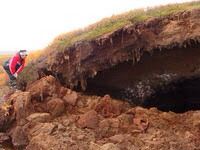Disappearing Arctic ice, which gets most of the attention from climate scientists, is an effect of humanmade climate change. By contrast, the melting of frozen soil, or permafrost, can drive warming. As it thaws, microbes devour carbon previously locked inside, unleashing carbon dioxide—a potent greenhouse gas—in the process. The carbon dioxide amplifies the warming power of carbon pollution in a vicious feedback loop.
Scientists have struggled, however, to quantify this threat. Permafrost occurs on a quarter of the Northern Hemisphere landmass—from Alaska to Canada and across Siberia—but researchers have taken far too few readings to feel very confident about the risk. "We are working on really large landmasses with limited data," says physical geographer Gustaf Hugelius of Stockholm University. Measuring the carbon content of permafrost requires muddy field work with heavy drilling machinery, operated in remote areas, and satellite data help little.
Those logistical constraints have largely limited researchers' previous estimates of carbon to the top meter of permafrost. But scientists think that carbon down to a depth of 3 meters is susceptible to thawing and release as well. An influential 2009 estimate that Arctic permafrost held 1.6 trillion metric tons of carbon included only 45 field sites analyzed down to that depth. In the new study, Hugelius added 405 new analyses of field sites that went to 3 meters, some through new field work he and colleagues performed, some from archived data. Adding up the carbon found in different soil types he says, yields an initial new estimate of 1894 billion metric tons of carbon locked into permafrost across the Arctic, 13% more than the previous estimate.
After better quantifying the size of stored Arctic carbon, the next question for <http://news.sciencemag.org/sciencenow/2012/12/editor-content.html?cs=UTF-8> researchers is how much permafrost will thaw as the planet warms. A modeling study published earlier this year suggested that if global emissions trends stay constant, by 2100 permafrost holding 436 gigatons of carbon could thaw. But determining the size of the permafrost threat also requires calculating how much of the carbon in thawed permafrost will be decomposed by microbes and released as CO2. In a presentation at the meeting, soil biogeochemist Christina Schaedel of the University of Florida in Gainesville discussed that question. She analyzed nine previous studies in which researchers took samples of thawed permafrost to discover how much carbon would be released. In those studies, researchers incubated the soil in bottles at constant temperatures in their laboratories for a year or more. Over 50 years, she concludes, thawed permafrost could release 20% of its available carbon, a figure she called "a conservative estimate."
That could amount to a carbon pulse larger than 2 years' worth of global humanmade emissions. In terms of global climate change, the new studies show that "the actual situation is worse" than policymakers realize, says Peter Griffith, an ecosystems ecologist with NASA's Goddard Space Flight Center in Greenbelt, Maryland. The result could be an acceleration of impacts from humanmade greenhouse gas pollution: sea level rise, more intense droughts, and ocean acidification. "What happens in the Arctic doesn't stay in the Arctic," he says.
Painting a more complete picture of the threat means tackling the data dearth, says Hugelius, who hopes new collaborations with Russian scientists will provide a wealth of archived soil data from various laboratories across northern Asia. In addition, Hugelius and Schaedel are members of a network<http://www.biology.ufl.edu/permafrostcarbon/> of scientists studying permafrost carbon in the Arctic, and Griffith is leading a new project by NASA in which scientists will fan out across the Arctic over the next decade to obtain more data on soil carbon and ice.
In terms of Arctic studies, "ice gets all the love," Griffith says. "That's because we have a very robust [satellite] capability for remotely sensing ice." To understand the threat hidden within permafrost, it's time for more scientists to get their boots dirty. More
